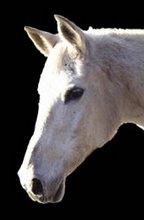In horse magazines and books you constantly read about the problem of overbreeding, and how there are too many people producing too many poor horses for the available market. This is undeniably a problem, as evidenced by the fact that at many auctions it is possible to buy registered purebreds for $50 to $100, which is less than $0.10 a pound! The rescues, which try to save as many as possible from slaughter and adopt them out to good homes, are always full. Nobody likes the slaughter industry, but right now it serves a useful purpose in providing a necessary "release valve" for the extra horses, and while there is much debate, I believe it is a better alternative than we would see without it. I truly hate the idea of all those horses starving to death slowly rather than quickly and humanely killed. And I'm afraid that too many people that say they love horses casually breed new babies every year and add to the very problem they are trying to outlaw.
However, one thing I have never seen addressed is the math of breeding. Exactly how many new horses do we need every year to replace the ones that die, without increasing the net population? What would responsible breeding look like? So, I sat down and worked out the math.
Per population of 1,000 horses:
Assuming the average lifespan is 33 years, we would need approximately 30 new foals each year to maintain a steady population.
If we assume that once a mare begins breeding she continues to produce a foal every year, we would only need about 30 full-time broodmares. However, let us be more generous and also allow for hobby breeders and good mares that also need to be ridden more. So, let's assume that each mare only foals every 4 years. About 1/2 of any foal crop is fillies, and the other 1/2 are colts. So, out of 500 mares in this population, only about 120 would ever be used as broodmares.
Now, stallions have successfully bred over 100 mares a year. However, most people believe it is a lot healthier to restrict a stud to 30 to 60 mares or so as a healthier balance. A breeding stallion should however have the opportunity to breed a good number of mares every year or else it is not fair to him, and he may become more dangerous out of frustration (all stallions, no matter how well-trained, are still dangerous - it's the nature of the hormones). Let us say that each stallion breeds 30 mares a year. Thus we only need 1 stallion per 1,000 horses. This means that out of every 500 colts born, only 1 should remain a stud. All the others should be gelded.
Conclusion:
To responsibly maintain a steady population of horses and ensure a continual improvement of quality, only the best colt out of 500 colts born should ever be used for breeding, and only the best 25% of mares should ever be used for breeding.
There you have it! A handy objective formula to help you evaluate your horse for its quality and suitability in a responsible breeding program.
L
Sunday, February 25, 2007
Subscribe to:
Post Comments (Atom)


4 comments:
My math teacher makes up story problems for us. I should give him this one! I think the most important thing is that every horse has a happy and healthy home, and being responsible with breeding can help horses to have better lives.
Glad you liked it! Yes, one of the best ways we can help horse have better lives is by being responsible about breeding.
As a breeder, I totally agree that we need to be responsible about breeding and that means not being barn blind to the quality of our horses.
But I'm concerned while your math may come up with the proper head count, it fails to take into account what would happen to the gene pool. While it may be true a stallion can breed x number of mares, it doesn't mean he does or should or that he settles all of those mares. By having a small number of stallions breeding all of the available mares, the gene pool would be compromised. As a breeder, one of the responsibilites should be maintaining the integrity of the gene pool. Once that intergrity has been compromised, there is no way to fix it.
I agree that only outstanding individuals should be bred and probablly your 25% number for mares is a good one for most breeds but the numbers of stallions should probably be equal to the mares. Mother Nature has a reason for those foals being born fifty/fifty colts and fillies. We, humans, have gotten ourselves in more than enough trouble over the years thinking we knew more than Mother Nature.
Great, thought provoking post.
Thanks for your comment!
Re: the stallions - of course it would be OK to breed a stud through pasture breeding and only have him with 5-10 mares, for example, which is more like in the wild. In that case you could end up with as many as 6 studs per 1,000 population. I don't know if I agree that the number of stallions needs to be equal to the number of mares, though, for genetic diversity...
Thanks for the input!
Post a Comment